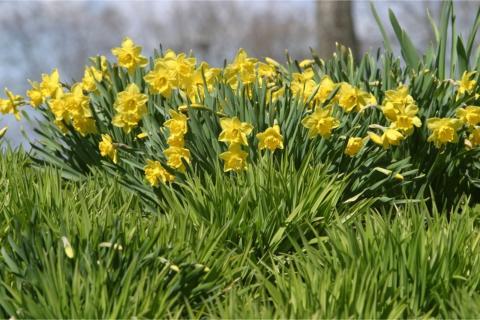Add Garden Bulbs For A Continuation Of Color
All Year Long
Garden bulbs make a valuable contribution to the low-maintenance garden, producing colorful flowers for virtually any time of the year. The great thing is that the majority of bulbs will flower reliably year after year, with clumps growing and improving all the time, and once they have been planted they need very little attention.
Most summer-flowering bulbs, such as alliums and lilies, are best planted in groups in a border.
However, the easiest way to grow many spring and fall flowering ones such as Crocus bulbs is to naturalize them in grass.
This eliminates the need for annual replanting and means that you don’t have to cut that part of the lawn until the leaves have died down naturally.
It's advisable to keep naturalized bulbs restricted to one small area of the lawn so that the rest can be cut normally, that way it won’t look too cluttered.

Caring for Bulbs
Naturalized
bulbs and those left in a border for many years will eventually need
dividing to prevent overcrowding, which would overtime lead to
deteriorating results.
Lift large clumps when the leaves have
just died back, or any time when the bulbs are dormant. Separate the
clump into smaller pieces and replant. You do not have to separate them
into individual bulbs.
Naturalizing Large Bulbs
To
create a natural effect, scatter the bulbs on the grass and plant them
where they fall. Make a hole for each, roughly three times their own
depth, using either a trowel or a bulb planter, which pulls out a neat
plug of grass and soil. Insertion will be easier if the ground is moist
rather than dry.
Place a bulb in the hole, then crumble a little
soil from the bottom of the plug and let it fall around the bulb to make
sure it will not be left in a pocket of air. Press the plug back into
position afterwards.
Naturalizing Small Bulbs
For
small garden bulbs and corms it is sometimes easier to lift and then replace
the grass. This can be done by using a spade to slice beneath the grass,
and then roll it back for planting.
Loosen the soil with a fork,
and work in a slow-acting fertilizer such as bone meal. Scatter the
bulbs randomly as a uniform pattern will look unnatural in grass. Small
ones can be left on the surface; larger ones are best buried slightly.
Make
sure to cover the bulbs with twice their own depth of soil under the
grass, firm it well with your hands and then water thoroughly.
Gardening Tools › Garden Bulbs








New! Comments
Have your say about what you just read! Leave me a comment in the box below.